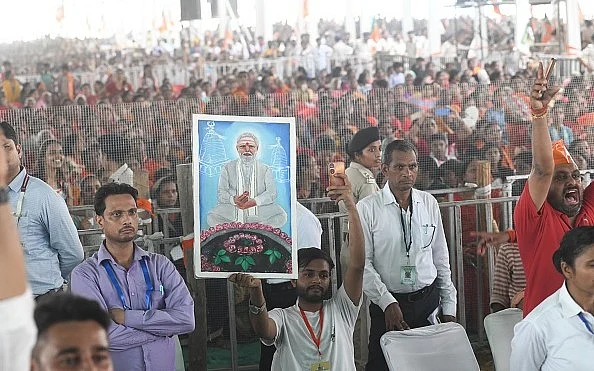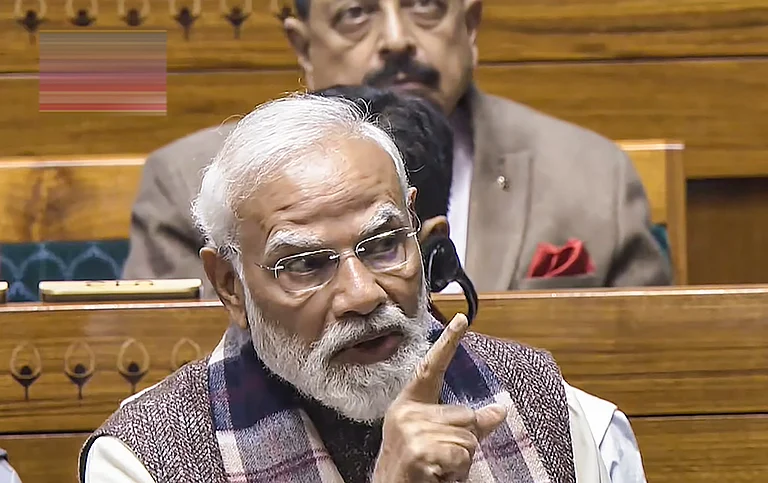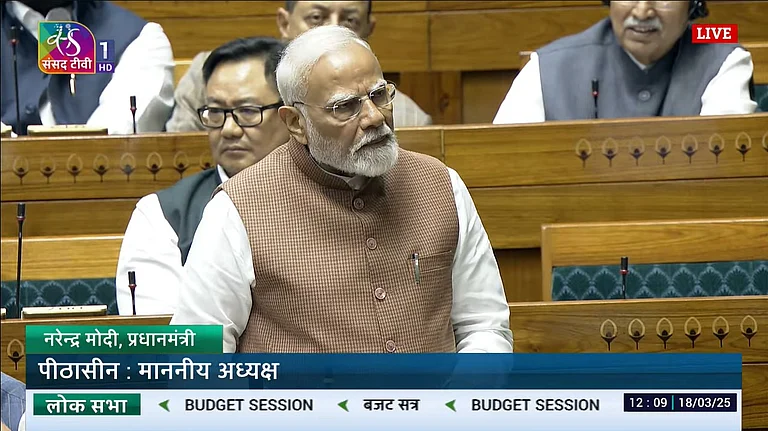On May 30, when Prime Minister Narendra Modi arrived at the southern-most point of mainland India, the Vivekananda Rock Memorial in Tamil Nadu, to perform a ‘maun vrat’ (silent contemplation), it brought down the curtains on what may go down in history as one of the most bitterly fought electoral campaigns in India.
Amidst a series of heatwaves, the seven-phase Lok Sabha election stretching over two months saw the 73-year-old Modi attending over 200 rallies and roadshows and giving over six dozen media interviews.
Modi’s Bharatiya Janata Party (BJP), ruling India with a comfortable majority since 2014, was widely seen as the favourite well before the election was announced. The opposition INDIA bloc had a limited central strategy and no prime ministerial face.
One of the first things political observers and journalists pointed out after the beginning of the campaign was that there was no wave – neither pro-incumbency nor anti-incumbency. This was mostly seen as a sign of the status quo. In the 543-seat Lok Sabha, the lower House of the Indian parliament, the BJP won 303 seats in 2019 and its allies got another 50.
Modi started his campaign in April highlighting the achievements and ambitions of his government while seeking a third term. But as the campaign progressed, there came a twist in the narrative. A section of political observers and analysts started calling the contest closer than earlier perceived.
To an extent, such observations might have been prompted by PM Modi’s switch in campaign gear.
On April 21, two days after the first phase of elections, Modi brought up religion in the discourse rather aggressively while addressing a rally in Rajasthan’s Banswara. He alleged that the opposition, led by the Congress, was planning to take away the wealth of the Hindus and distribute them among Muslims. His use of the word “infiltrator” was seen as a reference to Muslims.
Subsequently, he alleged that Congress would also rob Hindu backward castes of reservation benefits and give those away to Muslims and that Congress has no regard for the Constitution and would try to change it to appease Muslims. The Congress would not even spare the Hindu matrimonial jewellery mangal sutra from married women, he alleged.
Some political observers suspected Modi was getting desperate sensing that things were not as smooth as he expected. Others thought he was trying to energise the party’s core voter base so that they do not fall prey to complacency. Some suspected Modi was alarmed by the low polling rate compared to the last election.
Whatever the trigger, Modi continued with the same line of campaign despite facing criticism for misrepresenting the contents of the opposition parties’ manifestos.
As the election progressed, his pitch on the question of reservation – that the opposition will give those away to Muslims – only sharpened.
Not only did he turn communal issues into his campaign focus but he also claimed divinity for himself. Modi said that he was convinced that his birth was not biological but god had sent him on purpose and that the kind of energy that he possessed could not have come from a biological body (of his mother).
A Puzzling Campaign
If Modi’s main campaign pitch in 2014 was against corruption and in 2019 it was national security, in 2024 it was saving Hindus from the Opposition’s plot to please Muslims at the cost of Hindus.
If there was no wave, Modi left no stone unturned to build an anti-opposition wave over alleged Muslim appeasement.
Modi’s aggressive anti-Muslim pitch puzzled many political observers, even some BJP leaders in Bihar and Uttar Pradesh, as the party had last year launched an outreach programme for the Pasmanda Muslims, a backward community making up the majority of Indian Muslims, eyeing their votes.
All the outreach work of the past seven to eight months has gone into vain, BJP leaders suspect. This could cost the party some close-contest seats in Uttar Pradesh and Bihar, some BJP leaders feared. Others were confident that the party would gain more Hindu votes by reviving the original Hindu nationalist line.
The Congress, the main opposition party, took digs at the BJP for campaigning on a communal line. They submitted a series of complaints to the Election Commission of India.
Party president Mallikarjun Kharge alleged that during the entire campaign, Modi used “Mandir-Masjid and divisive issues 421 times” and referred to “Muslims, Pakistan and minority 224 times” but never mentioned unemployment.
Before the last phase election, Modi’s predecessor, former Congress PM Manmohan Singh, released an open letter in which he launched a scathing attack on Modi, alleging that Modi had “indulged in the most vicious form of hate speeches” as “the first prime minister to lower the dignity of public discourse, and thereby the gravity of the office of the prime minister.”
Throughout the campaign, Congress tried to maintain their focus on their core issues – unemployment, inflation, social justice, democracy, growing wealth inequality and backward caste and community empowerment, among others. It kept its focus on the issue of caste census, which the Congress claimed would help ensure an equitable distribution of wealth and opportunities.
However, the allegations of quid pro quo over raising funds through the Electoral Bond Scheme that the Supreme Court struck down rarely came up in the Opposition’s campaign.
Knives Out
In different states, the battle with regional opposition parties was also intense. Modi made unexpected personal attacks on Odisha Chief Minister and Biju Janata Dal head Naveen Patnaik and Maharashtra’s Nationalist Congress Party (Sharadchandra Pawar) chief Sharad Pawar.
Modi alleged that the Congress’ electoral manifesto had the imprints of the Muslim League, the pre-independence outfit led by Mohammad Ali Jinnah that fought for India’s partition and paved the creation of Pakistan. It never existed in independent India. Modi also alleged that the Congress manifesto had ultra-Left Maoist influence.
Curiously, Modi even blamed Congress for striking a secret deal with Adani and Ambani industrial groups that are perceived to enjoy a good rapport with Modi himself. He kept referring to Congress leader Rahul Gandhi as shehzada, the Urdu word for a prince.
The campaign in the national capital of Delhi heated up after Delhi Chief Minister Arvind Kejriwal of the Aam Aadmi Party (AAP), who came out of jail on a temporary bail for the election campaign, told his supporters that other opposition chief ministers like West Bengal’s Mamata Banerjee and Kerala’s Pinarayi Vijayan would also land in jail if Modi returns to power.
The election period also saw opposition parties and civil society personalities expressing repeated doubts about the neutrality of the Election Commission of India, alleging that they were acting in favour of the ruling dispensation.
The commission’s delay in releasing voter turnout figures and revision of turnouts triggered controversies and the Commission was dragged to the court. The Commission also faced criticism for not acting against Modi for his alleged “hate speeches”. However, the judiciary preferred not to interfere in the Commission’s domain. The Commission criticised the Congress for casting aspersions on its credibility.
The Mood
The election puzzled psephologists for a range of reasons. First, the absence of a wave makes the contest in each constituency dependent on its specific equations – localised voter satisfaction or anger – making the outcomes in many seats more uncertain. In 2014 and 2019, the Modi wave had made up for the BJP’s local weaknesses.
At the grassroots level, issues changed from constituency to constituency, depending on the incumbent's performance, caste and religious questions, the public impression of contesting candidates and the performance of the state government and local administration.
Second, the election has been marked by low voter turnout, which adds to the uncertainty. It could mean complacency among ruling party voters or lack of motivation among opposition voters. Both could be a product of the same perception that whatever happens, Ayega to Modi Hi (Modi’s going to return to power anyway).
And third, journalists noticed a large number of ‘silent voters’. Were the demotivated BJP voters who were no longer overtly enthusiastic about the party but would still vote for Modi due to a lack of a credible alternative? Or were they disenchanted voters planning to vote for change?
Besides, poll pundits like Sanjay Kumar of Lokniti-CSDS, one of India’s premiere political research institutes, said that when they conducted a survey in the first week of April, they concluded that the BJP’s vote share would be around 40%, of which around 4-5% might be reluctant BJP voters, who are not happy with the government but may end up voting for the BJP because they see no alternative.
After receiving reports from the first five phases, Kumar felt that the narrative had changed and these reluctant voters had started moving away from the BJP.
“When opposition parties used to say this was an election to save democracy and the Constitution, I used to laugh and think that this was not an issue for the common people. But when the BJP called for 370 seats for itself and 400 plus for the NDA, the Opposition tried to turn the BJP’s strength into weakness. They started campaigning that the BJP wanted 370 seats to change the Constitution and they kept hammering hard,” Kumar said during an event.
He added that the BJP’s call also connected to PM Modi’s promise of strong steps in the first 100 days. “All these started changing the narrative and the big narratives like voting on Modi, Hindutva and temple made way for smaller issues,” he said.
On the other hand, US-based political scientist and global political risk analyst Ian Bremmer, who visited India, predicted that Modi’s BJP will have a similar number of seats as last time.
“It does look very clear that he is going to win,” Bremmer said, adding, “He is one of the most popular leaders in any major democracy in the world.”
Among Indian psephologists, Premchand Palety, the founder of the election research institute C-Fore has said the possibility of the INDIA bloc coming to power could not be ruled out. Psephologist-turned-political activist Yogendra Yadav said the BJP’s numbers will be below 250.
Political strategist Prashant Kishor predicted the BJP’s comfortable return to power. Political analyst Rahul Verma of the New Delhi-based Centre for Policy Research predicted the BJP to get the majority mark.
“Congress is unlikely to cross the 75-80 mark and the BJP’s worst could be around 240-250. The BJP’s tally would likely be lower than indicated in the pre-poll surveys but I still think they will cross the majority mark,” said Verma during a TV show.
“When the campaign started, a section of our workers, supporters and voters were complacent. But after Modi-ji raised the campaign pitch and some experts started saying the contest was getting closer, the last few phases saw our worker and supporter base fully energised,” says a leader of West Bengal BJP unwilling to be named.
On June 1, almost all exit polls predicted Modi’s return to power with a similar or even greater majority.
In an election marked by the absence of any wave, was there any undercurrent? June 4 will tell.




























